Auditing and Assurance Services
VerifiedAdded on 2023/06/05
|15
|3632
|434
AI Summary
This report analyzes assertion risks and applies substantive audit procedures for addressing audit assertion risks. It also analyzes the requirements of ASA 707 Communicating Key Audit Matters.
Contribute Materials
Your contribution can guide someone’s learning journey. Share your
documents today.
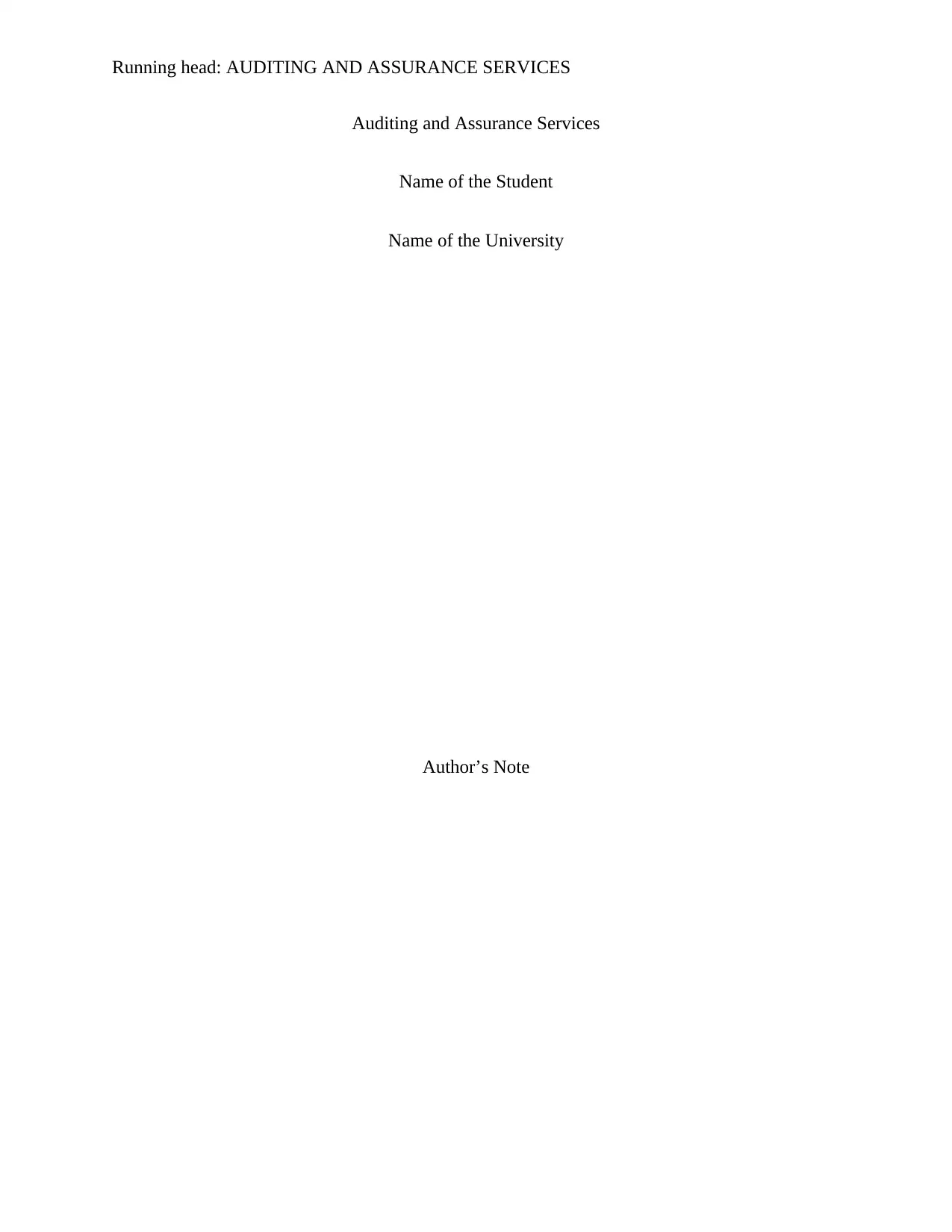
Running head: AUDITING AND ASSURANCE SERVICES
Auditing and Assurance Services
Name of the Student
Name of the University
Author’s Note
Auditing and Assurance Services
Name of the Student
Name of the University
Author’s Note
Secure Best Marks with AI Grader
Need help grading? Try our AI Grader for instant feedback on your assignments.
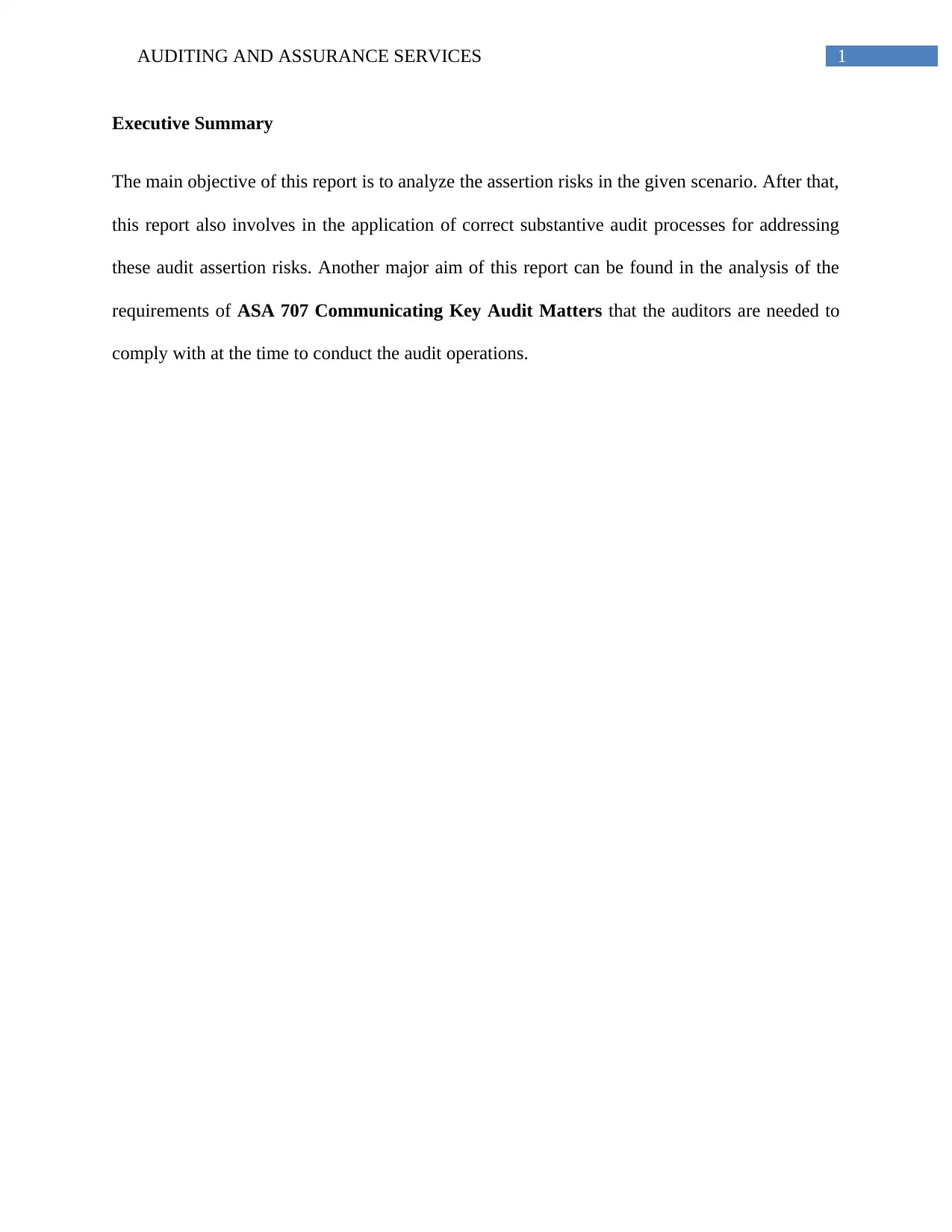
1AUDITING AND ASSURANCE SERVICES
Executive Summary
The main objective of this report is to analyze the assertion risks in the given scenario. After that,
this report also involves in the application of correct substantive audit processes for addressing
these audit assertion risks. Another major aim of this report can be found in the analysis of the
requirements of ASA 707 Communicating Key Audit Matters that the auditors are needed to
comply with at the time to conduct the audit operations.
Executive Summary
The main objective of this report is to analyze the assertion risks in the given scenario. After that,
this report also involves in the application of correct substantive audit processes for addressing
these audit assertion risks. Another major aim of this report can be found in the analysis of the
requirements of ASA 707 Communicating Key Audit Matters that the auditors are needed to
comply with at the time to conduct the audit operations.
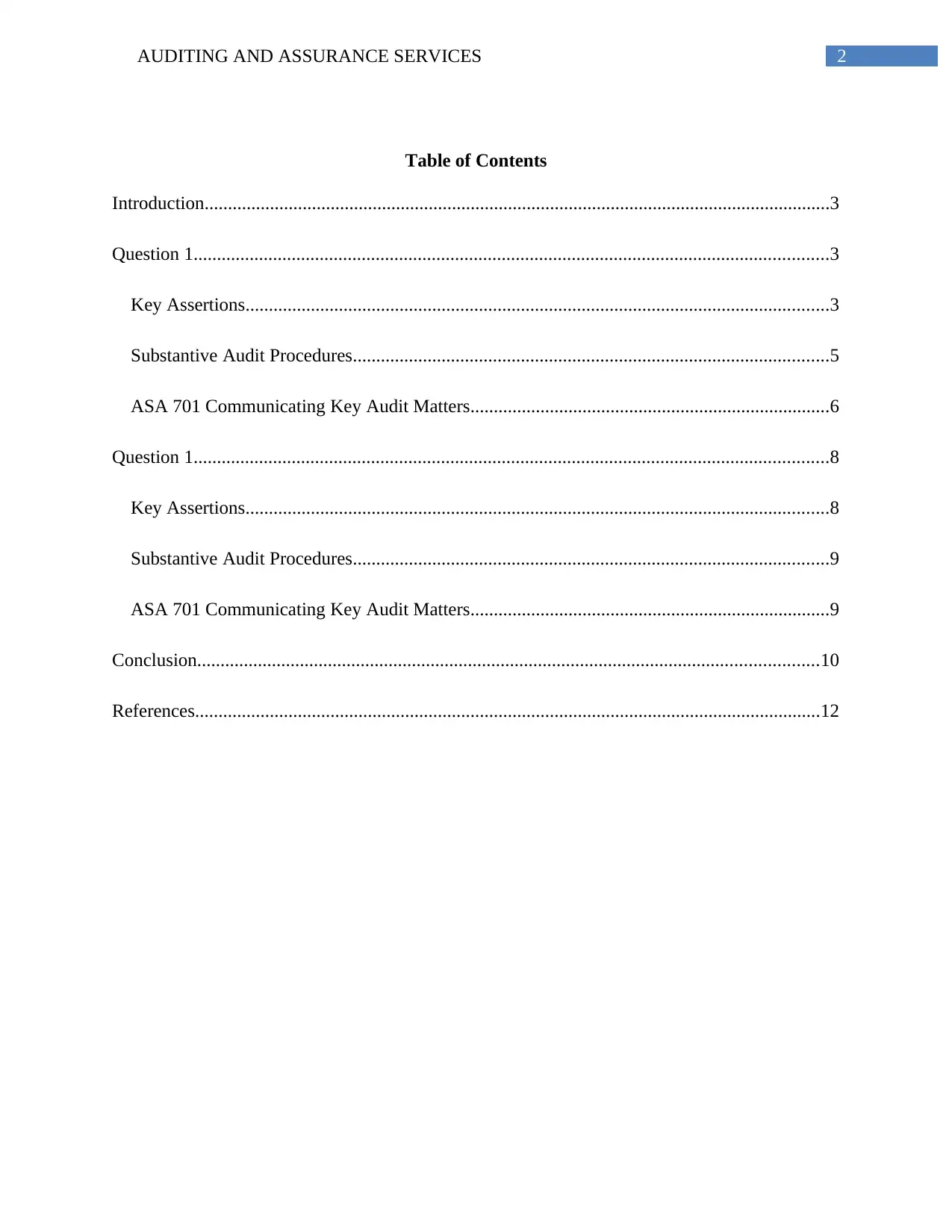
2AUDITING AND ASSURANCE SERVICES
Table of Contents
Introduction......................................................................................................................................3
Question 1........................................................................................................................................3
Key Assertions.............................................................................................................................3
Substantive Audit Procedures......................................................................................................5
ASA 701 Communicating Key Audit Matters.............................................................................6
Question 1........................................................................................................................................8
Key Assertions.............................................................................................................................8
Substantive Audit Procedures......................................................................................................9
ASA 701 Communicating Key Audit Matters.............................................................................9
Conclusion.....................................................................................................................................10
References......................................................................................................................................12
Table of Contents
Introduction......................................................................................................................................3
Question 1........................................................................................................................................3
Key Assertions.............................................................................................................................3
Substantive Audit Procedures......................................................................................................5
ASA 701 Communicating Key Audit Matters.............................................................................6
Question 1........................................................................................................................................8
Key Assertions.............................................................................................................................8
Substantive Audit Procedures......................................................................................................9
ASA 701 Communicating Key Audit Matters.............................................................................9
Conclusion.....................................................................................................................................10
References......................................................................................................................................12
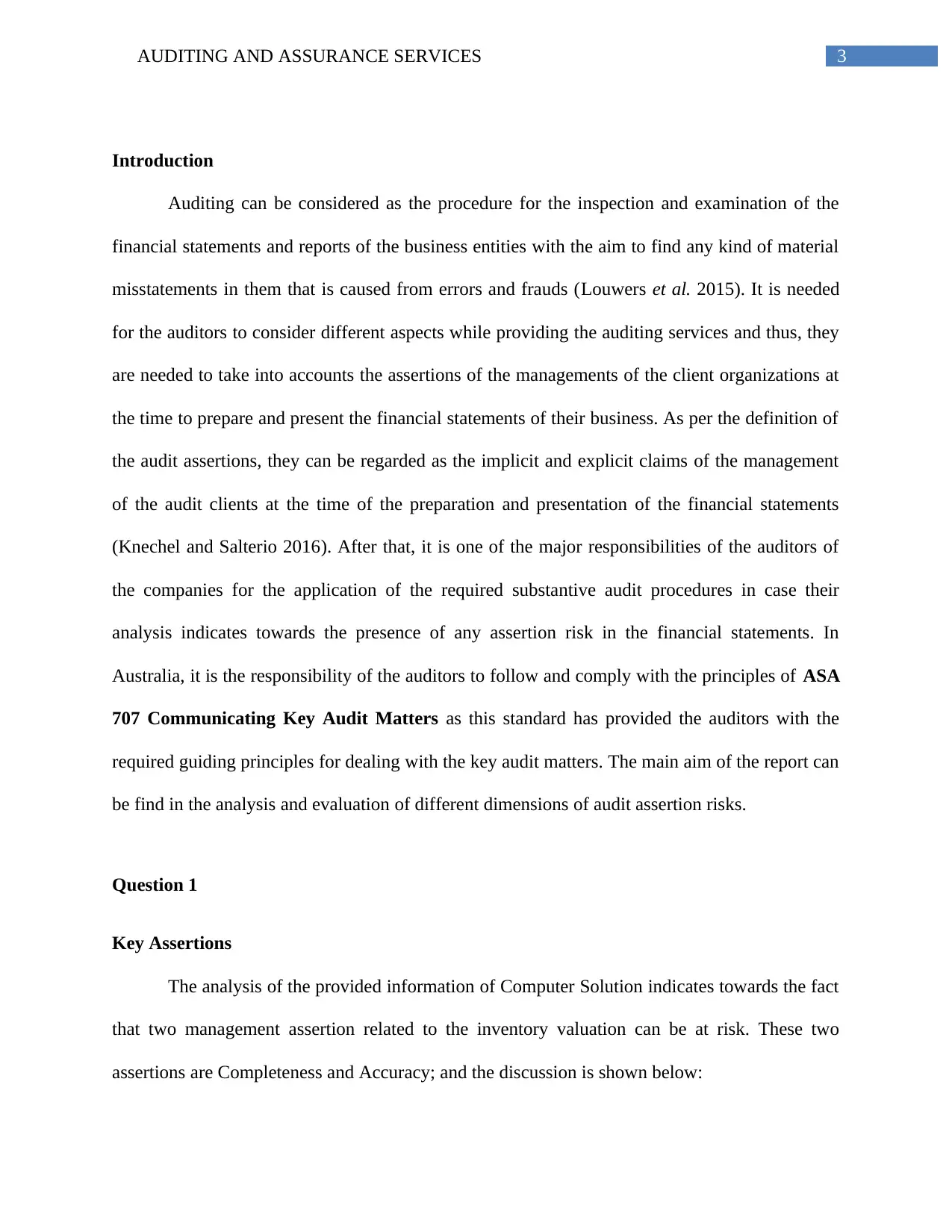
3AUDITING AND ASSURANCE SERVICES
Introduction
Auditing can be considered as the procedure for the inspection and examination of the
financial statements and reports of the business entities with the aim to find any kind of material
misstatements in them that is caused from errors and frauds (Louwers et al. 2015). It is needed
for the auditors to consider different aspects while providing the auditing services and thus, they
are needed to take into accounts the assertions of the managements of the client organizations at
the time to prepare and present the financial statements of their business. As per the definition of
the audit assertions, they can be regarded as the implicit and explicit claims of the management
of the audit clients at the time of the preparation and presentation of the financial statements
(Knechel and Salterio 2016). After that, it is one of the major responsibilities of the auditors of
the companies for the application of the required substantive audit procedures in case their
analysis indicates towards the presence of any assertion risk in the financial statements. In
Australia, it is the responsibility of the auditors to follow and comply with the principles of ASA
707 Communicating Key Audit Matters as this standard has provided the auditors with the
required guiding principles for dealing with the key audit matters. The main aim of the report can
be find in the analysis and evaluation of different dimensions of audit assertion risks.
Question 1
Key Assertions
The analysis of the provided information of Computer Solution indicates towards the fact
that two management assertion related to the inventory valuation can be at risk. These two
assertions are Completeness and Accuracy; and the discussion is shown below:
Introduction
Auditing can be considered as the procedure for the inspection and examination of the
financial statements and reports of the business entities with the aim to find any kind of material
misstatements in them that is caused from errors and frauds (Louwers et al. 2015). It is needed
for the auditors to consider different aspects while providing the auditing services and thus, they
are needed to take into accounts the assertions of the managements of the client organizations at
the time to prepare and present the financial statements of their business. As per the definition of
the audit assertions, they can be regarded as the implicit and explicit claims of the management
of the audit clients at the time of the preparation and presentation of the financial statements
(Knechel and Salterio 2016). After that, it is one of the major responsibilities of the auditors of
the companies for the application of the required substantive audit procedures in case their
analysis indicates towards the presence of any assertion risk in the financial statements. In
Australia, it is the responsibility of the auditors to follow and comply with the principles of ASA
707 Communicating Key Audit Matters as this standard has provided the auditors with the
required guiding principles for dealing with the key audit matters. The main aim of the report can
be find in the analysis and evaluation of different dimensions of audit assertion risks.
Question 1
Key Assertions
The analysis of the provided information of Computer Solution indicates towards the fact
that two management assertion related to the inventory valuation can be at risk. These two
assertions are Completeness and Accuracy; and the discussion is shown below:
Secure Best Marks with AI Grader
Need help grading? Try our AI Grader for instant feedback on your assignments.
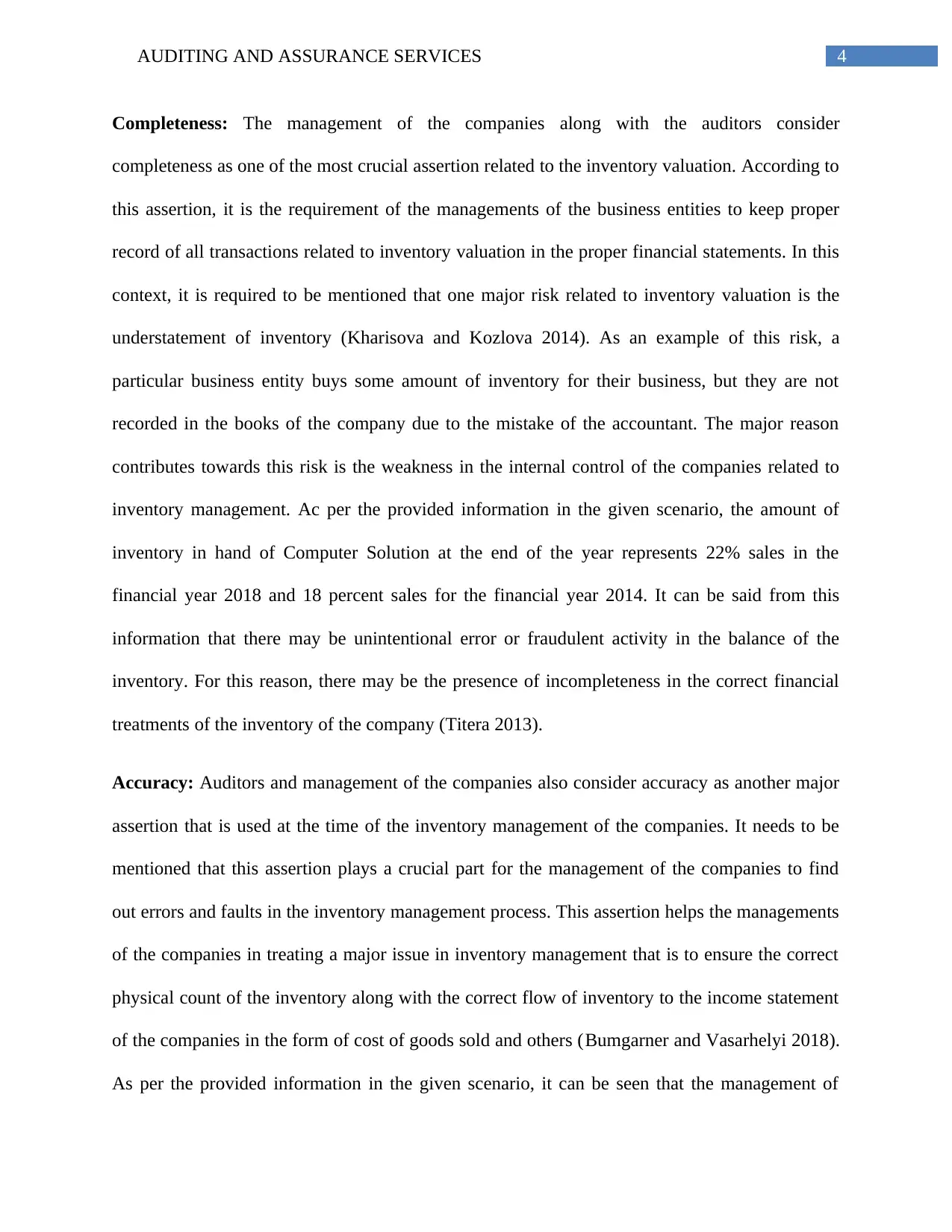
4AUDITING AND ASSURANCE SERVICES
Completeness: The management of the companies along with the auditors consider
completeness as one of the most crucial assertion related to the inventory valuation. According to
this assertion, it is the requirement of the managements of the business entities to keep proper
record of all transactions related to inventory valuation in the proper financial statements. In this
context, it is required to be mentioned that one major risk related to inventory valuation is the
understatement of inventory (Kharisova and Kozlova 2014). As an example of this risk, a
particular business entity buys some amount of inventory for their business, but they are not
recorded in the books of the company due to the mistake of the accountant. The major reason
contributes towards this risk is the weakness in the internal control of the companies related to
inventory management. Ac per the provided information in the given scenario, the amount of
inventory in hand of Computer Solution at the end of the year represents 22% sales in the
financial year 2018 and 18 percent sales for the financial year 2014. It can be said from this
information that there may be unintentional error or fraudulent activity in the balance of the
inventory. For this reason, there may be the presence of incompleteness in the correct financial
treatments of the inventory of the company (Titera 2013).
Accuracy: Auditors and management of the companies also consider accuracy as another major
assertion that is used at the time of the inventory management of the companies. It needs to be
mentioned that this assertion plays a crucial part for the management of the companies to find
out errors and faults in the inventory management process. This assertion helps the managements
of the companies in treating a major issue in inventory management that is to ensure the correct
physical count of the inventory along with the correct flow of inventory to the income statement
of the companies in the form of cost of goods sold and others (Bumgarner and Vasarhelyi 2018).
As per the provided information in the given scenario, it can be seen that the management of
Completeness: The management of the companies along with the auditors consider
completeness as one of the most crucial assertion related to the inventory valuation. According to
this assertion, it is the requirement of the managements of the business entities to keep proper
record of all transactions related to inventory valuation in the proper financial statements. In this
context, it is required to be mentioned that one major risk related to inventory valuation is the
understatement of inventory (Kharisova and Kozlova 2014). As an example of this risk, a
particular business entity buys some amount of inventory for their business, but they are not
recorded in the books of the company due to the mistake of the accountant. The major reason
contributes towards this risk is the weakness in the internal control of the companies related to
inventory management. Ac per the provided information in the given scenario, the amount of
inventory in hand of Computer Solution at the end of the year represents 22% sales in the
financial year 2018 and 18 percent sales for the financial year 2014. It can be said from this
information that there may be unintentional error or fraudulent activity in the balance of the
inventory. For this reason, there may be the presence of incompleteness in the correct financial
treatments of the inventory of the company (Titera 2013).
Accuracy: Auditors and management of the companies also consider accuracy as another major
assertion that is used at the time of the inventory management of the companies. It needs to be
mentioned that this assertion plays a crucial part for the management of the companies to find
out errors and faults in the inventory management process. This assertion helps the managements
of the companies in treating a major issue in inventory management that is to ensure the correct
physical count of the inventory along with the correct flow of inventory to the income statement
of the companies in the form of cost of goods sold and others (Bumgarner and Vasarhelyi 2018).
As per the provided information in the given scenario, it can be seen that the management of
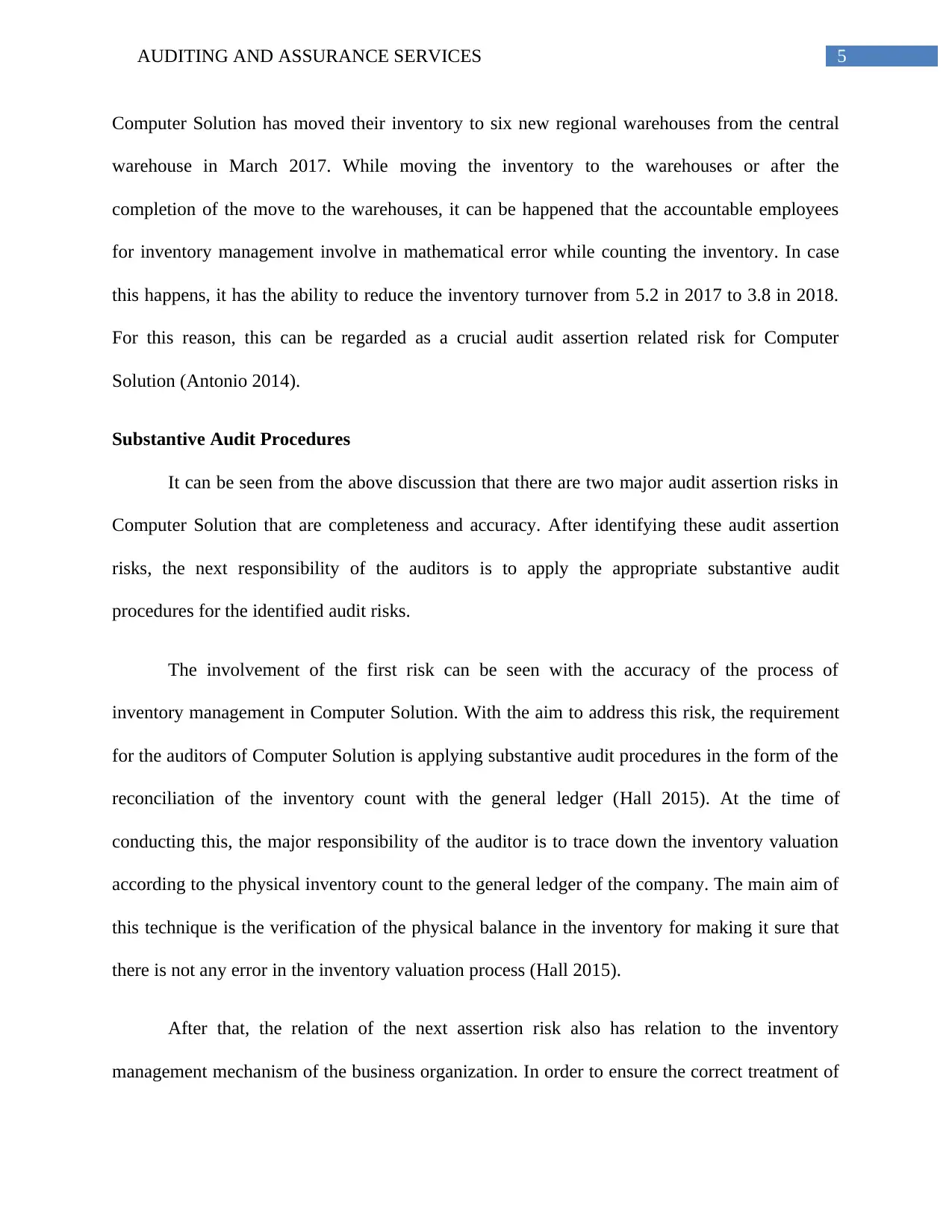
5AUDITING AND ASSURANCE SERVICES
Computer Solution has moved their inventory to six new regional warehouses from the central
warehouse in March 2017. While moving the inventory to the warehouses or after the
completion of the move to the warehouses, it can be happened that the accountable employees
for inventory management involve in mathematical error while counting the inventory. In case
this happens, it has the ability to reduce the inventory turnover from 5.2 in 2017 to 3.8 in 2018.
For this reason, this can be regarded as a crucial audit assertion related risk for Computer
Solution (Antonio 2014).
Substantive Audit Procedures
It can be seen from the above discussion that there are two major audit assertion risks in
Computer Solution that are completeness and accuracy. After identifying these audit assertion
risks, the next responsibility of the auditors is to apply the appropriate substantive audit
procedures for the identified audit risks.
The involvement of the first risk can be seen with the accuracy of the process of
inventory management in Computer Solution. With the aim to address this risk, the requirement
for the auditors of Computer Solution is applying substantive audit procedures in the form of the
reconciliation of the inventory count with the general ledger (Hall 2015). At the time of
conducting this, the major responsibility of the auditor is to trace down the inventory valuation
according to the physical inventory count to the general ledger of the company. The main aim of
this technique is the verification of the physical balance in the inventory for making it sure that
there is not any error in the inventory valuation process (Hall 2015).
After that, the relation of the next assertion risk also has relation to the inventory
management mechanism of the business organization. In order to ensure the correct treatment of
Computer Solution has moved their inventory to six new regional warehouses from the central
warehouse in March 2017. While moving the inventory to the warehouses or after the
completion of the move to the warehouses, it can be happened that the accountable employees
for inventory management involve in mathematical error while counting the inventory. In case
this happens, it has the ability to reduce the inventory turnover from 5.2 in 2017 to 3.8 in 2018.
For this reason, this can be regarded as a crucial audit assertion related risk for Computer
Solution (Antonio 2014).
Substantive Audit Procedures
It can be seen from the above discussion that there are two major audit assertion risks in
Computer Solution that are completeness and accuracy. After identifying these audit assertion
risks, the next responsibility of the auditors is to apply the appropriate substantive audit
procedures for the identified audit risks.
The involvement of the first risk can be seen with the accuracy of the process of
inventory management in Computer Solution. With the aim to address this risk, the requirement
for the auditors of Computer Solution is applying substantive audit procedures in the form of the
reconciliation of the inventory count with the general ledger (Hall 2015). At the time of
conducting this, the major responsibility of the auditor is to trace down the inventory valuation
according to the physical inventory count to the general ledger of the company. The main aim of
this technique is the verification of the physical balance in the inventory for making it sure that
there is not any error in the inventory valuation process (Hall 2015).
After that, the relation of the next assertion risk also has relation to the inventory
management mechanism of the business organization. In order to ensure the correct treatment of
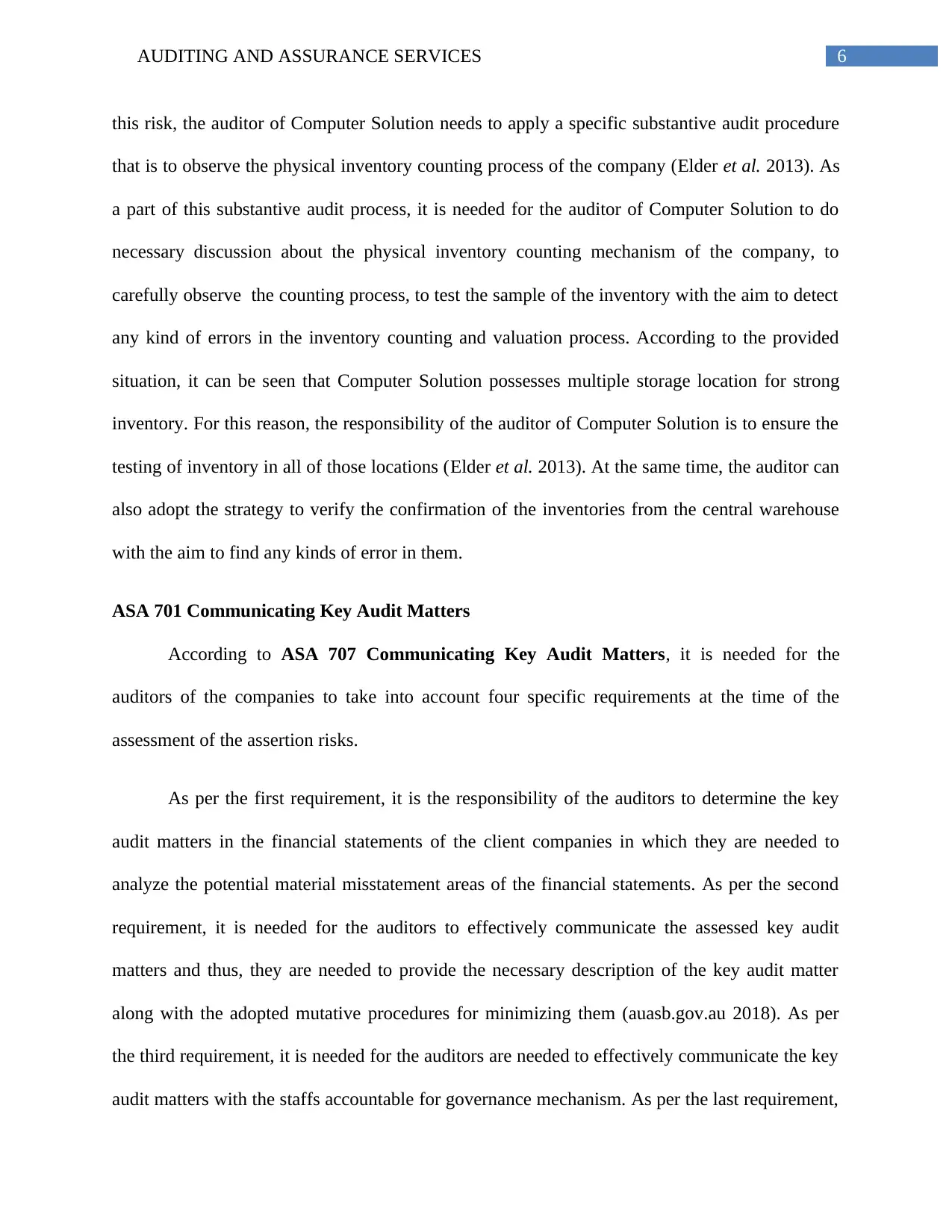
6AUDITING AND ASSURANCE SERVICES
this risk, the auditor of Computer Solution needs to apply a specific substantive audit procedure
that is to observe the physical inventory counting process of the company (Elder et al. 2013). As
a part of this substantive audit process, it is needed for the auditor of Computer Solution to do
necessary discussion about the physical inventory counting mechanism of the company, to
carefully observe the counting process, to test the sample of the inventory with the aim to detect
any kind of errors in the inventory counting and valuation process. According to the provided
situation, it can be seen that Computer Solution possesses multiple storage location for strong
inventory. For this reason, the responsibility of the auditor of Computer Solution is to ensure the
testing of inventory in all of those locations (Elder et al. 2013). At the same time, the auditor can
also adopt the strategy to verify the confirmation of the inventories from the central warehouse
with the aim to find any kinds of error in them.
ASA 701 Communicating Key Audit Matters
According to ASA 707 Communicating Key Audit Matters, it is needed for the
auditors of the companies to take into account four specific requirements at the time of the
assessment of the assertion risks.
As per the first requirement, it is the responsibility of the auditors to determine the key
audit matters in the financial statements of the client companies in which they are needed to
analyze the potential material misstatement areas of the financial statements. As per the second
requirement, it is needed for the auditors to effectively communicate the assessed key audit
matters and thus, they are needed to provide the necessary description of the key audit matter
along with the adopted mutative procedures for minimizing them (auasb.gov.au 2018). As per
the third requirement, it is needed for the auditors are needed to effectively communicate the key
audit matters with the staffs accountable for governance mechanism. As per the last requirement,
this risk, the auditor of Computer Solution needs to apply a specific substantive audit procedure
that is to observe the physical inventory counting process of the company (Elder et al. 2013). As
a part of this substantive audit process, it is needed for the auditor of Computer Solution to do
necessary discussion about the physical inventory counting mechanism of the company, to
carefully observe the counting process, to test the sample of the inventory with the aim to detect
any kind of errors in the inventory counting and valuation process. According to the provided
situation, it can be seen that Computer Solution possesses multiple storage location for strong
inventory. For this reason, the responsibility of the auditor of Computer Solution is to ensure the
testing of inventory in all of those locations (Elder et al. 2013). At the same time, the auditor can
also adopt the strategy to verify the confirmation of the inventories from the central warehouse
with the aim to find any kinds of error in them.
ASA 701 Communicating Key Audit Matters
According to ASA 707 Communicating Key Audit Matters, it is needed for the
auditors of the companies to take into account four specific requirements at the time of the
assessment of the assertion risks.
As per the first requirement, it is the responsibility of the auditors to determine the key
audit matters in the financial statements of the client companies in which they are needed to
analyze the potential material misstatement areas of the financial statements. As per the second
requirement, it is needed for the auditors to effectively communicate the assessed key audit
matters and thus, they are needed to provide the necessary description of the key audit matter
along with the adopted mutative procedures for minimizing them (auasb.gov.au 2018). As per
the third requirement, it is needed for the auditors are needed to effectively communicate the key
audit matters with the staffs accountable for governance mechanism. As per the last requirement,
Paraphrase This Document
Need a fresh take? Get an instant paraphrase of this document with our AI Paraphraser
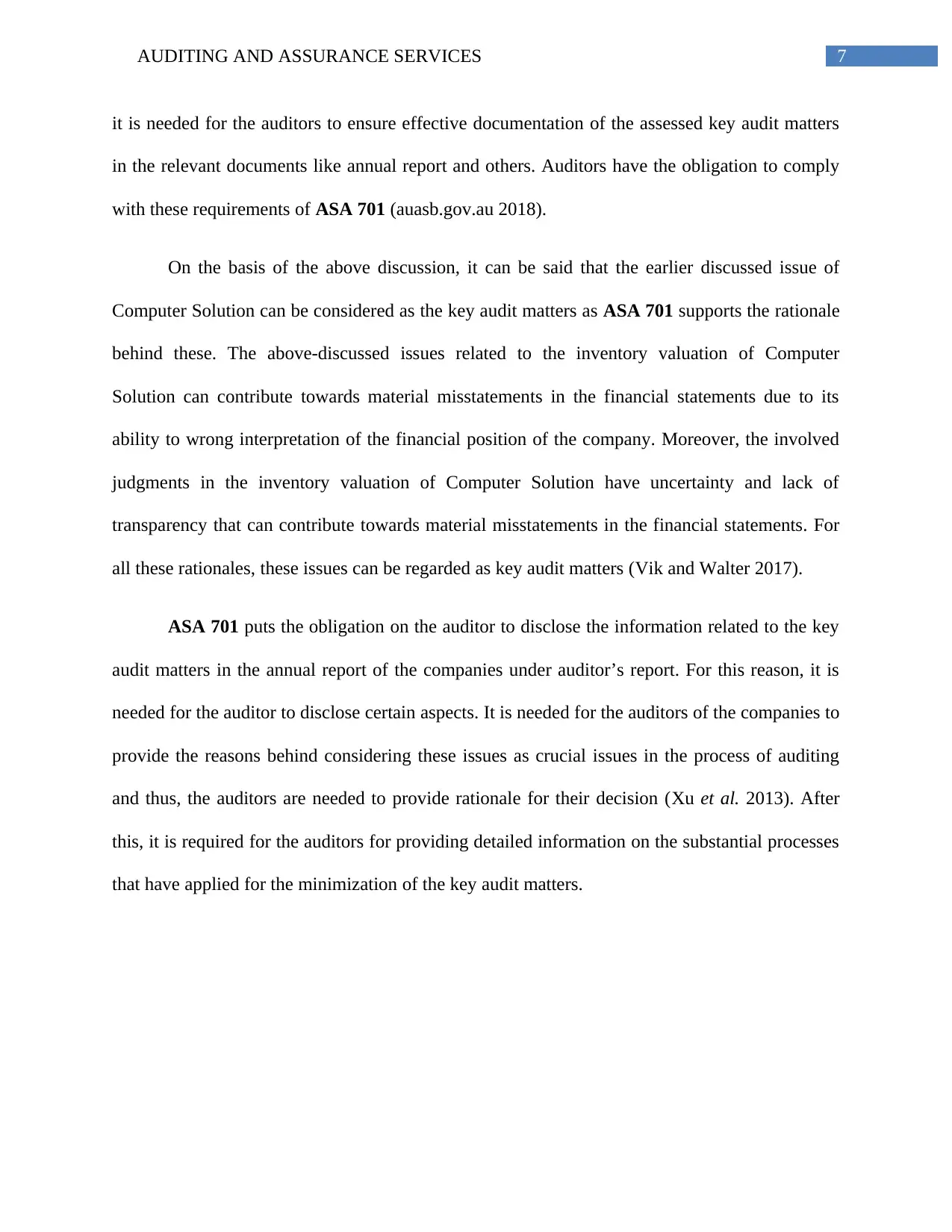
7AUDITING AND ASSURANCE SERVICES
it is needed for the auditors to ensure effective documentation of the assessed key audit matters
in the relevant documents like annual report and others. Auditors have the obligation to comply
with these requirements of ASA 701 (auasb.gov.au 2018).
On the basis of the above discussion, it can be said that the earlier discussed issue of
Computer Solution can be considered as the key audit matters as ASA 701 supports the rationale
behind these. The above-discussed issues related to the inventory valuation of Computer
Solution can contribute towards material misstatements in the financial statements due to its
ability to wrong interpretation of the financial position of the company. Moreover, the involved
judgments in the inventory valuation of Computer Solution have uncertainty and lack of
transparency that can contribute towards material misstatements in the financial statements. For
all these rationales, these issues can be regarded as key audit matters (Vik and Walter 2017).
ASA 701 puts the obligation on the auditor to disclose the information related to the key
audit matters in the annual report of the companies under auditor’s report. For this reason, it is
needed for the auditor to disclose certain aspects. It is needed for the auditors of the companies to
provide the reasons behind considering these issues as crucial issues in the process of auditing
and thus, the auditors are needed to provide rationale for their decision (Xu et al. 2013). After
this, it is required for the auditors for providing detailed information on the substantial processes
that have applied for the minimization of the key audit matters.
it is needed for the auditors to ensure effective documentation of the assessed key audit matters
in the relevant documents like annual report and others. Auditors have the obligation to comply
with these requirements of ASA 701 (auasb.gov.au 2018).
On the basis of the above discussion, it can be said that the earlier discussed issue of
Computer Solution can be considered as the key audit matters as ASA 701 supports the rationale
behind these. The above-discussed issues related to the inventory valuation of Computer
Solution can contribute towards material misstatements in the financial statements due to its
ability to wrong interpretation of the financial position of the company. Moreover, the involved
judgments in the inventory valuation of Computer Solution have uncertainty and lack of
transparency that can contribute towards material misstatements in the financial statements. For
all these rationales, these issues can be regarded as key audit matters (Vik and Walter 2017).
ASA 701 puts the obligation on the auditor to disclose the information related to the key
audit matters in the annual report of the companies under auditor’s report. For this reason, it is
needed for the auditor to disclose certain aspects. It is needed for the auditors of the companies to
provide the reasons behind considering these issues as crucial issues in the process of auditing
and thus, the auditors are needed to provide rationale for their decision (Xu et al. 2013). After
this, it is required for the auditors for providing detailed information on the substantial processes
that have applied for the minimization of the key audit matters.
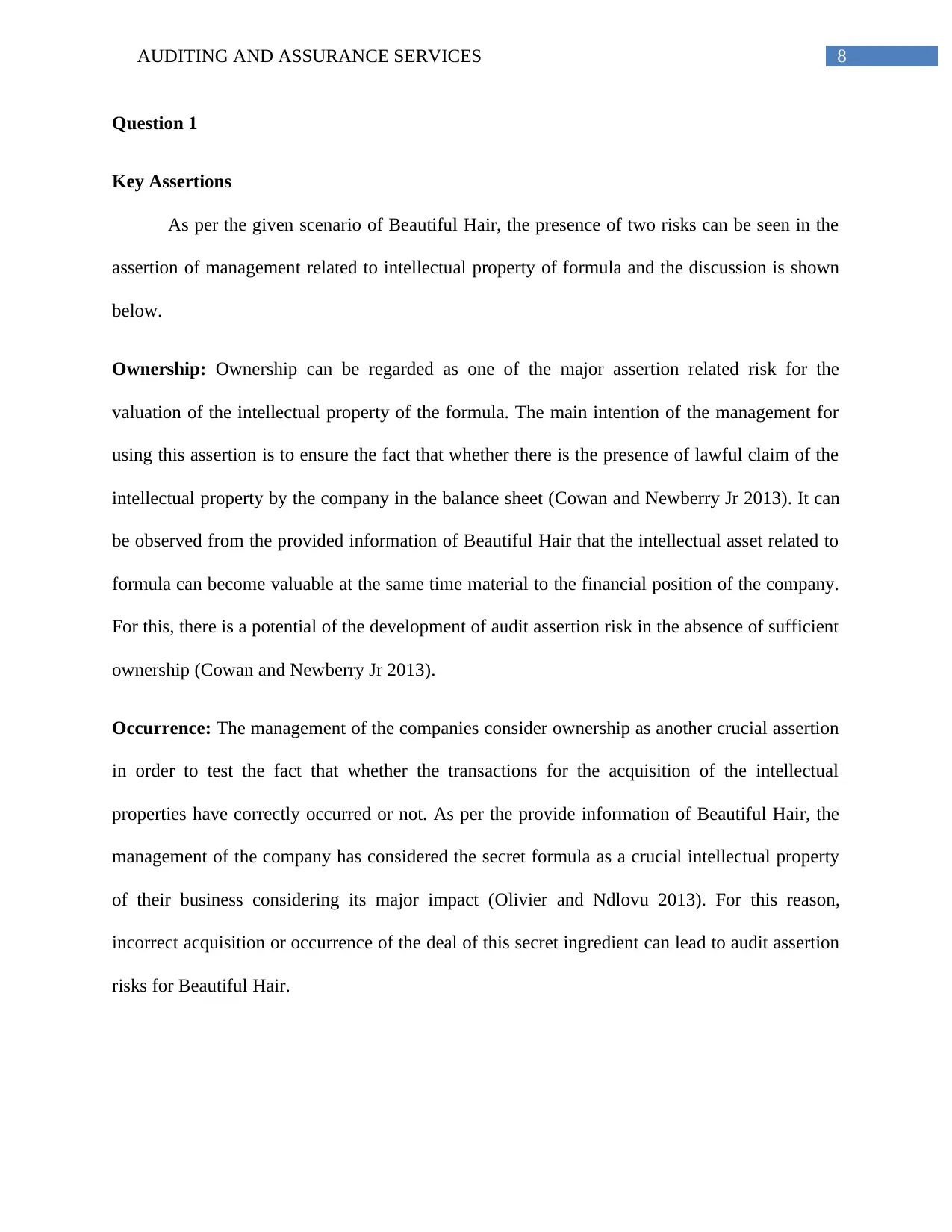
8AUDITING AND ASSURANCE SERVICES
Question 1
Key Assertions
As per the given scenario of Beautiful Hair, the presence of two risks can be seen in the
assertion of management related to intellectual property of formula and the discussion is shown
below.
Ownership: Ownership can be regarded as one of the major assertion related risk for the
valuation of the intellectual property of the formula. The main intention of the management for
using this assertion is to ensure the fact that whether there is the presence of lawful claim of the
intellectual property by the company in the balance sheet (Cowan and Newberry Jr 2013). It can
be observed from the provided information of Beautiful Hair that the intellectual asset related to
formula can become valuable at the same time material to the financial position of the company.
For this, there is a potential of the development of audit assertion risk in the absence of sufficient
ownership (Cowan and Newberry Jr 2013).
Occurrence: The management of the companies consider ownership as another crucial assertion
in order to test the fact that whether the transactions for the acquisition of the intellectual
properties have correctly occurred or not. As per the provide information of Beautiful Hair, the
management of the company has considered the secret formula as a crucial intellectual property
of their business considering its major impact (Olivier and Ndlovu 2013). For this reason,
incorrect acquisition or occurrence of the deal of this secret ingredient can lead to audit assertion
risks for Beautiful Hair.
Question 1
Key Assertions
As per the given scenario of Beautiful Hair, the presence of two risks can be seen in the
assertion of management related to intellectual property of formula and the discussion is shown
below.
Ownership: Ownership can be regarded as one of the major assertion related risk for the
valuation of the intellectual property of the formula. The main intention of the management for
using this assertion is to ensure the fact that whether there is the presence of lawful claim of the
intellectual property by the company in the balance sheet (Cowan and Newberry Jr 2013). It can
be observed from the provided information of Beautiful Hair that the intellectual asset related to
formula can become valuable at the same time material to the financial position of the company.
For this, there is a potential of the development of audit assertion risk in the absence of sufficient
ownership (Cowan and Newberry Jr 2013).
Occurrence: The management of the companies consider ownership as another crucial assertion
in order to test the fact that whether the transactions for the acquisition of the intellectual
properties have correctly occurred or not. As per the provide information of Beautiful Hair, the
management of the company has considered the secret formula as a crucial intellectual property
of their business considering its major impact (Olivier and Ndlovu 2013). For this reason,
incorrect acquisition or occurrence of the deal of this secret ingredient can lead to audit assertion
risks for Beautiful Hair.
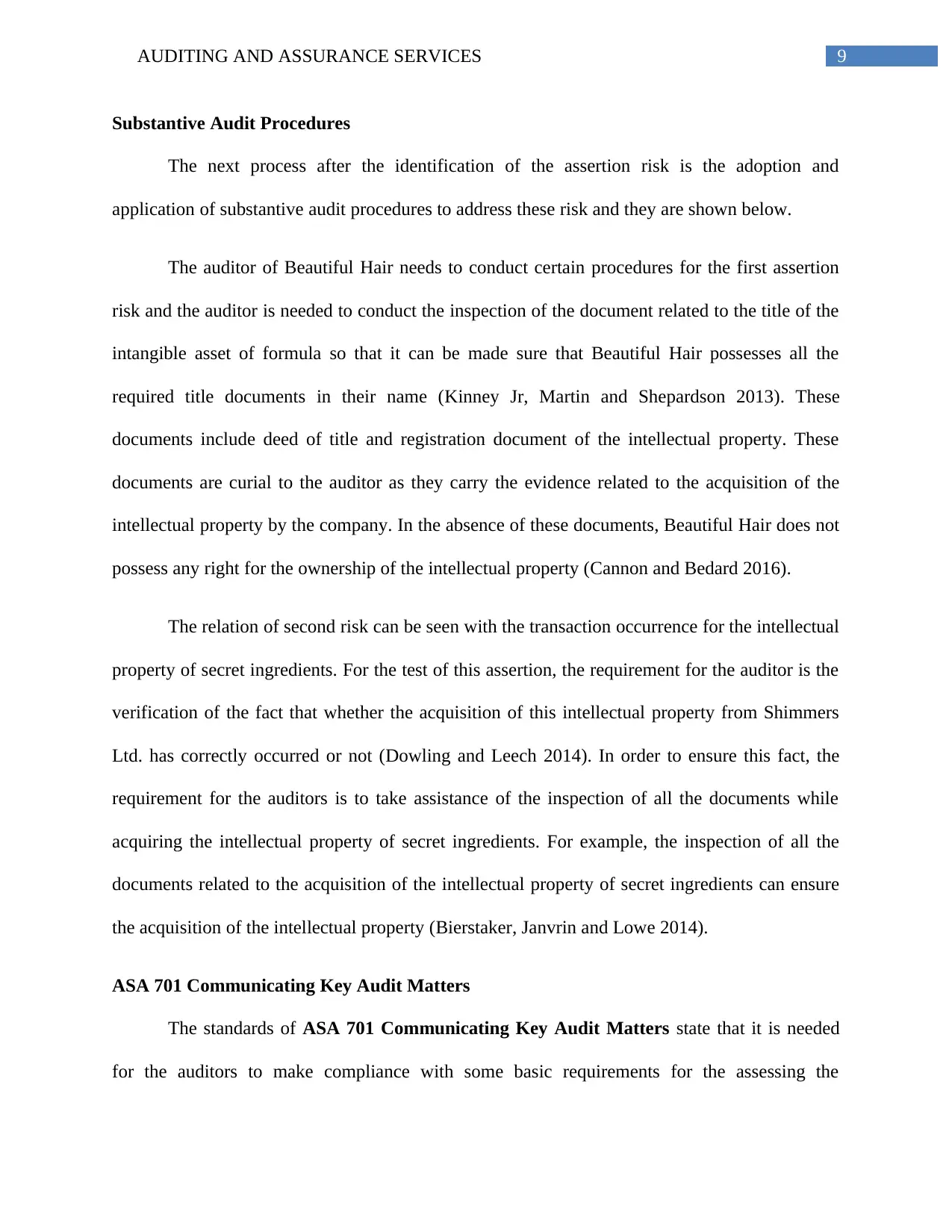
9AUDITING AND ASSURANCE SERVICES
Substantive Audit Procedures
The next process after the identification of the assertion risk is the adoption and
application of substantive audit procedures to address these risk and they are shown below.
The auditor of Beautiful Hair needs to conduct certain procedures for the first assertion
risk and the auditor is needed to conduct the inspection of the document related to the title of the
intangible asset of formula so that it can be made sure that Beautiful Hair possesses all the
required title documents in their name (Kinney Jr, Martin and Shepardson 2013). These
documents include deed of title and registration document of the intellectual property. These
documents are curial to the auditor as they carry the evidence related to the acquisition of the
intellectual property by the company. In the absence of these documents, Beautiful Hair does not
possess any right for the ownership of the intellectual property (Cannon and Bedard 2016).
The relation of second risk can be seen with the transaction occurrence for the intellectual
property of secret ingredients. For the test of this assertion, the requirement for the auditor is the
verification of the fact that whether the acquisition of this intellectual property from Shimmers
Ltd. has correctly occurred or not (Dowling and Leech 2014). In order to ensure this fact, the
requirement for the auditors is to take assistance of the inspection of all the documents while
acquiring the intellectual property of secret ingredients. For example, the inspection of all the
documents related to the acquisition of the intellectual property of secret ingredients can ensure
the acquisition of the intellectual property (Bierstaker, Janvrin and Lowe 2014).
ASA 701 Communicating Key Audit Matters
The standards of ASA 701 Communicating Key Audit Matters state that it is needed
for the auditors to make compliance with some basic requirements for the assessing the
Substantive Audit Procedures
The next process after the identification of the assertion risk is the adoption and
application of substantive audit procedures to address these risk and they are shown below.
The auditor of Beautiful Hair needs to conduct certain procedures for the first assertion
risk and the auditor is needed to conduct the inspection of the document related to the title of the
intangible asset of formula so that it can be made sure that Beautiful Hair possesses all the
required title documents in their name (Kinney Jr, Martin and Shepardson 2013). These
documents include deed of title and registration document of the intellectual property. These
documents are curial to the auditor as they carry the evidence related to the acquisition of the
intellectual property by the company. In the absence of these documents, Beautiful Hair does not
possess any right for the ownership of the intellectual property (Cannon and Bedard 2016).
The relation of second risk can be seen with the transaction occurrence for the intellectual
property of secret ingredients. For the test of this assertion, the requirement for the auditor is the
verification of the fact that whether the acquisition of this intellectual property from Shimmers
Ltd. has correctly occurred or not (Dowling and Leech 2014). In order to ensure this fact, the
requirement for the auditors is to take assistance of the inspection of all the documents while
acquiring the intellectual property of secret ingredients. For example, the inspection of all the
documents related to the acquisition of the intellectual property of secret ingredients can ensure
the acquisition of the intellectual property (Bierstaker, Janvrin and Lowe 2014).
ASA 701 Communicating Key Audit Matters
The standards of ASA 701 Communicating Key Audit Matters state that it is needed
for the auditors to make compliance with some basic requirements for the assessing the
Secure Best Marks with AI Grader
Need help grading? Try our AI Grader for instant feedback on your assignments.
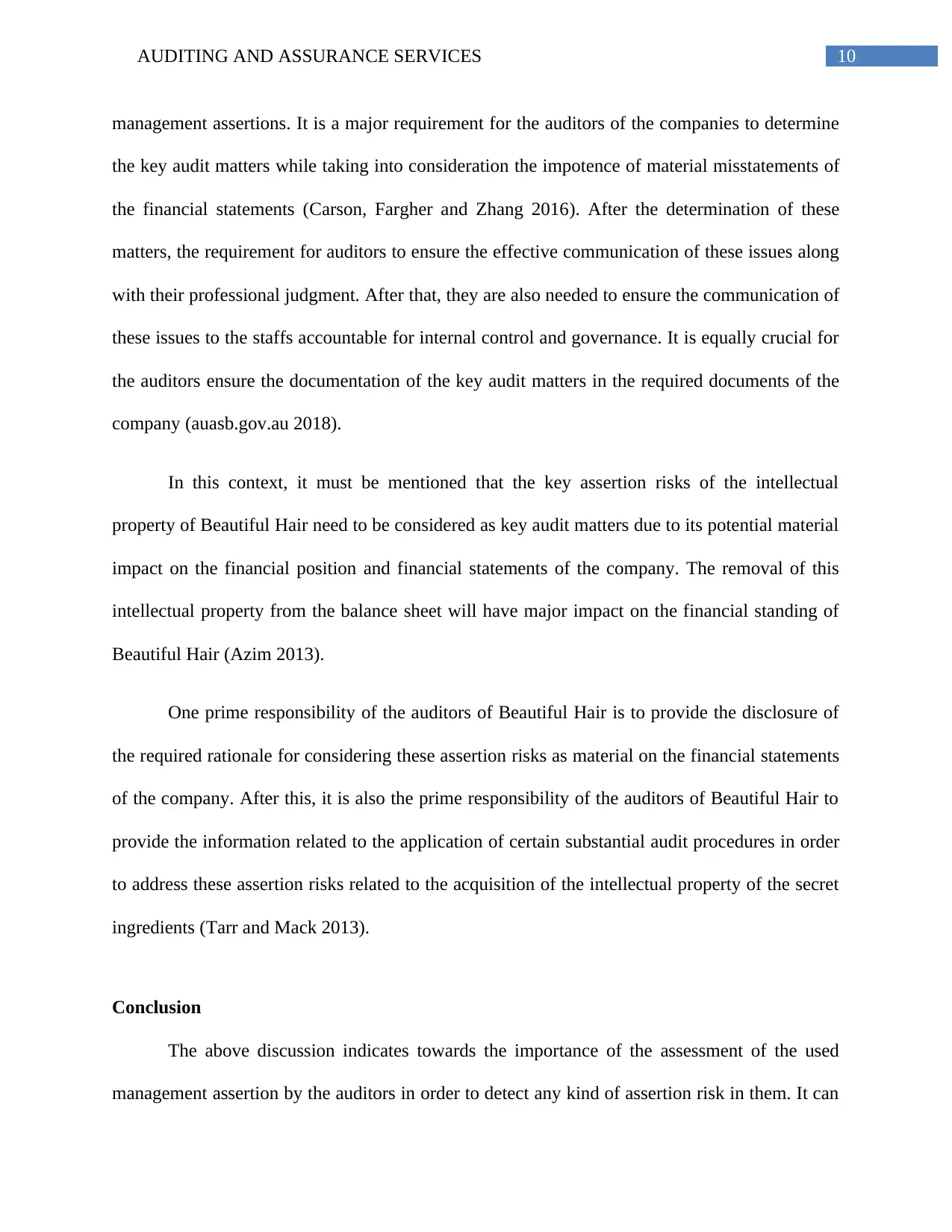
10AUDITING AND ASSURANCE SERVICES
management assertions. It is a major requirement for the auditors of the companies to determine
the key audit matters while taking into consideration the impotence of material misstatements of
the financial statements (Carson, Fargher and Zhang 2016). After the determination of these
matters, the requirement for auditors to ensure the effective communication of these issues along
with their professional judgment. After that, they are also needed to ensure the communication of
these issues to the staffs accountable for internal control and governance. It is equally crucial for
the auditors ensure the documentation of the key audit matters in the required documents of the
company (auasb.gov.au 2018).
In this context, it must be mentioned that the key assertion risks of the intellectual
property of Beautiful Hair need to be considered as key audit matters due to its potential material
impact on the financial position and financial statements of the company. The removal of this
intellectual property from the balance sheet will have major impact on the financial standing of
Beautiful Hair (Azim 2013).
One prime responsibility of the auditors of Beautiful Hair is to provide the disclosure of
the required rationale for considering these assertion risks as material on the financial statements
of the company. After this, it is also the prime responsibility of the auditors of Beautiful Hair to
provide the information related to the application of certain substantial audit procedures in order
to address these assertion risks related to the acquisition of the intellectual property of the secret
ingredients (Tarr and Mack 2013).
Conclusion
The above discussion indicates towards the importance of the assessment of the used
management assertion by the auditors in order to detect any kind of assertion risk in them. It can
management assertions. It is a major requirement for the auditors of the companies to determine
the key audit matters while taking into consideration the impotence of material misstatements of
the financial statements (Carson, Fargher and Zhang 2016). After the determination of these
matters, the requirement for auditors to ensure the effective communication of these issues along
with their professional judgment. After that, they are also needed to ensure the communication of
these issues to the staffs accountable for internal control and governance. It is equally crucial for
the auditors ensure the documentation of the key audit matters in the required documents of the
company (auasb.gov.au 2018).
In this context, it must be mentioned that the key assertion risks of the intellectual
property of Beautiful Hair need to be considered as key audit matters due to its potential material
impact on the financial position and financial statements of the company. The removal of this
intellectual property from the balance sheet will have major impact on the financial standing of
Beautiful Hair (Azim 2013).
One prime responsibility of the auditors of Beautiful Hair is to provide the disclosure of
the required rationale for considering these assertion risks as material on the financial statements
of the company. After this, it is also the prime responsibility of the auditors of Beautiful Hair to
provide the information related to the application of certain substantial audit procedures in order
to address these assertion risks related to the acquisition of the intellectual property of the secret
ingredients (Tarr and Mack 2013).
Conclusion
The above discussion indicates towards the importance of the assessment of the used
management assertion by the auditors in order to detect any kind of assertion risk in them. It can
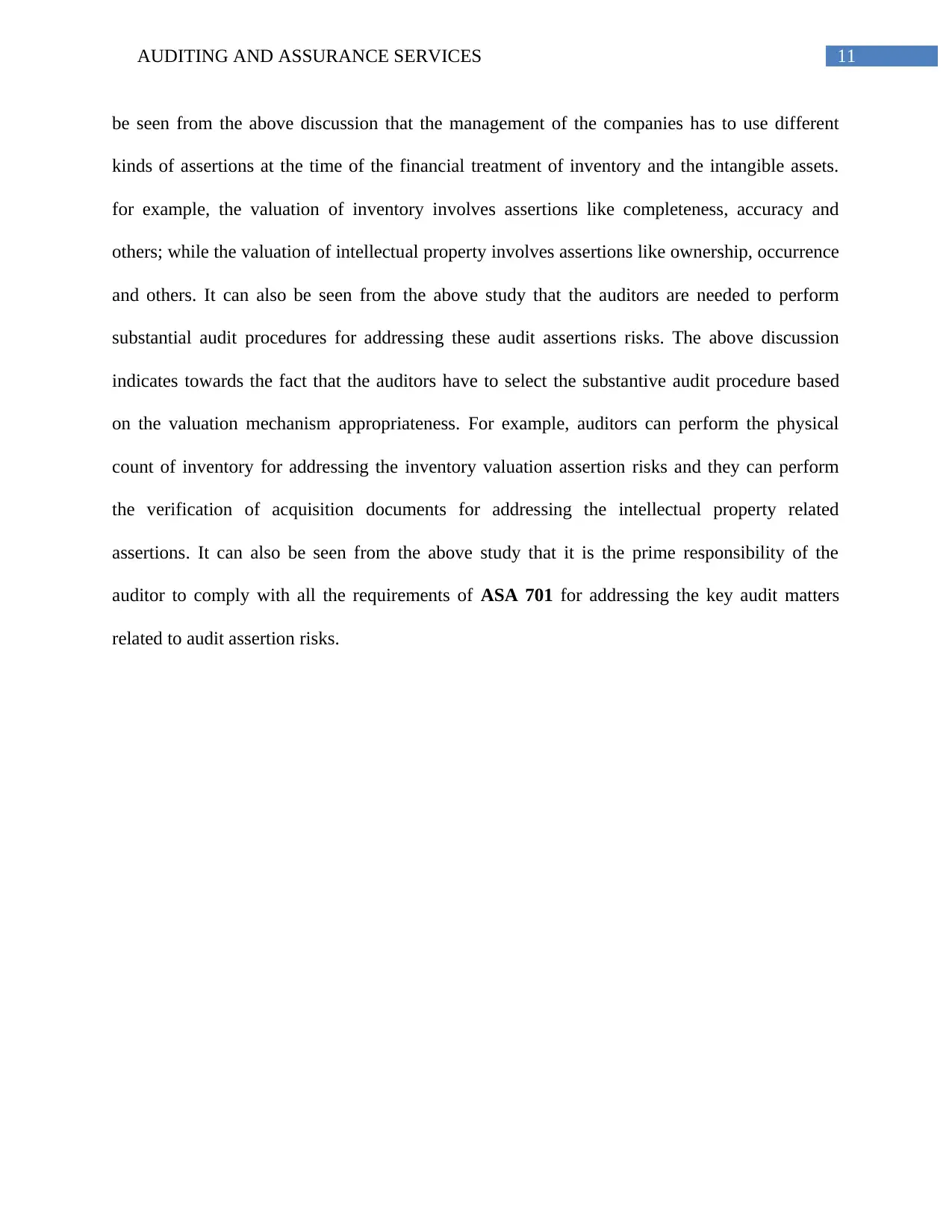
11AUDITING AND ASSURANCE SERVICES
be seen from the above discussion that the management of the companies has to use different
kinds of assertions at the time of the financial treatment of inventory and the intangible assets.
for example, the valuation of inventory involves assertions like completeness, accuracy and
others; while the valuation of intellectual property involves assertions like ownership, occurrence
and others. It can also be seen from the above study that the auditors are needed to perform
substantial audit procedures for addressing these audit assertions risks. The above discussion
indicates towards the fact that the auditors have to select the substantive audit procedure based
on the valuation mechanism appropriateness. For example, auditors can perform the physical
count of inventory for addressing the inventory valuation assertion risks and they can perform
the verification of acquisition documents for addressing the intellectual property related
assertions. It can also be seen from the above study that it is the prime responsibility of the
auditor to comply with all the requirements of ASA 701 for addressing the key audit matters
related to audit assertion risks.
be seen from the above discussion that the management of the companies has to use different
kinds of assertions at the time of the financial treatment of inventory and the intangible assets.
for example, the valuation of inventory involves assertions like completeness, accuracy and
others; while the valuation of intellectual property involves assertions like ownership, occurrence
and others. It can also be seen from the above study that the auditors are needed to perform
substantial audit procedures for addressing these audit assertions risks. The above discussion
indicates towards the fact that the auditors have to select the substantive audit procedure based
on the valuation mechanism appropriateness. For example, auditors can perform the physical
count of inventory for addressing the inventory valuation assertion risks and they can perform
the verification of acquisition documents for addressing the intellectual property related
assertions. It can also be seen from the above study that it is the prime responsibility of the
auditor to comply with all the requirements of ASA 701 for addressing the key audit matters
related to audit assertion risks.
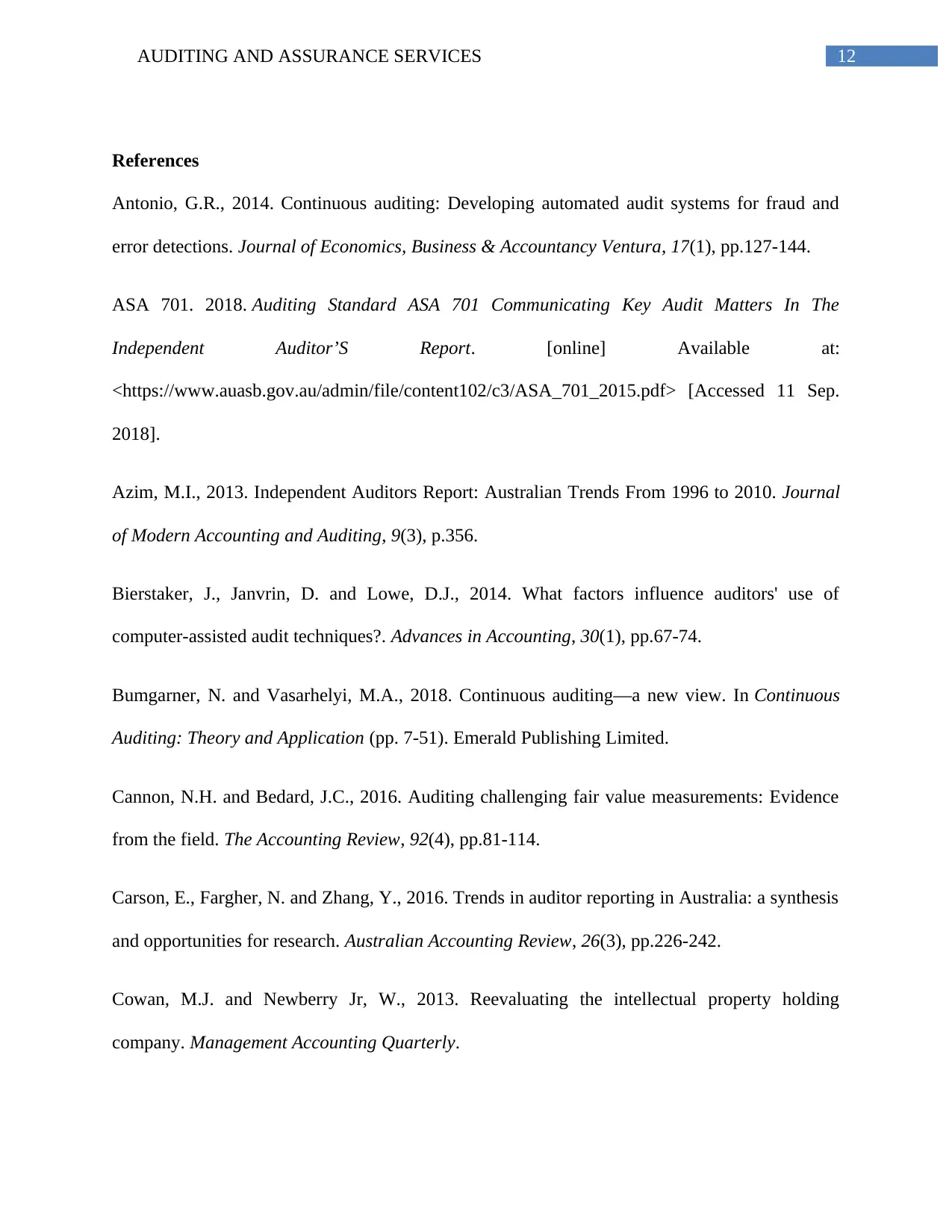
12AUDITING AND ASSURANCE SERVICES
References
Antonio, G.R., 2014. Continuous auditing: Developing automated audit systems for fraud and
error detections. Journal of Economics, Business & Accountancy Ventura, 17(1), pp.127-144.
ASA 701. 2018. Auditing Standard ASA 701 Communicating Key Audit Matters In The
Independent Auditor’S Report. [online] Available at:
<https://www.auasb.gov.au/admin/file/content102/c3/ASA_701_2015.pdf> [Accessed 11 Sep.
2018].
Azim, M.I., 2013. Independent Auditors Report: Australian Trends From 1996 to 2010. Journal
of Modern Accounting and Auditing, 9(3), p.356.
Bierstaker, J., Janvrin, D. and Lowe, D.J., 2014. What factors influence auditors' use of
computer-assisted audit techniques?. Advances in Accounting, 30(1), pp.67-74.
Bumgarner, N. and Vasarhelyi, M.A., 2018. Continuous auditing—a new view. In Continuous
Auditing: Theory and Application (pp. 7-51). Emerald Publishing Limited.
Cannon, N.H. and Bedard, J.C., 2016. Auditing challenging fair value measurements: Evidence
from the field. The Accounting Review, 92(4), pp.81-114.
Carson, E., Fargher, N. and Zhang, Y., 2016. Trends in auditor reporting in Australia: a synthesis
and opportunities for research. Australian Accounting Review, 26(3), pp.226-242.
Cowan, M.J. and Newberry Jr, W., 2013. Reevaluating the intellectual property holding
company. Management Accounting Quarterly.
References
Antonio, G.R., 2014. Continuous auditing: Developing automated audit systems for fraud and
error detections. Journal of Economics, Business & Accountancy Ventura, 17(1), pp.127-144.
ASA 701. 2018. Auditing Standard ASA 701 Communicating Key Audit Matters In The
Independent Auditor’S Report. [online] Available at:
<https://www.auasb.gov.au/admin/file/content102/c3/ASA_701_2015.pdf> [Accessed 11 Sep.
2018].
Azim, M.I., 2013. Independent Auditors Report: Australian Trends From 1996 to 2010. Journal
of Modern Accounting and Auditing, 9(3), p.356.
Bierstaker, J., Janvrin, D. and Lowe, D.J., 2014. What factors influence auditors' use of
computer-assisted audit techniques?. Advances in Accounting, 30(1), pp.67-74.
Bumgarner, N. and Vasarhelyi, M.A., 2018. Continuous auditing—a new view. In Continuous
Auditing: Theory and Application (pp. 7-51). Emerald Publishing Limited.
Cannon, N.H. and Bedard, J.C., 2016. Auditing challenging fair value measurements: Evidence
from the field. The Accounting Review, 92(4), pp.81-114.
Carson, E., Fargher, N. and Zhang, Y., 2016. Trends in auditor reporting in Australia: a synthesis
and opportunities for research. Australian Accounting Review, 26(3), pp.226-242.
Cowan, M.J. and Newberry Jr, W., 2013. Reevaluating the intellectual property holding
company. Management Accounting Quarterly.
Paraphrase This Document
Need a fresh take? Get an instant paraphrase of this document with our AI Paraphraser
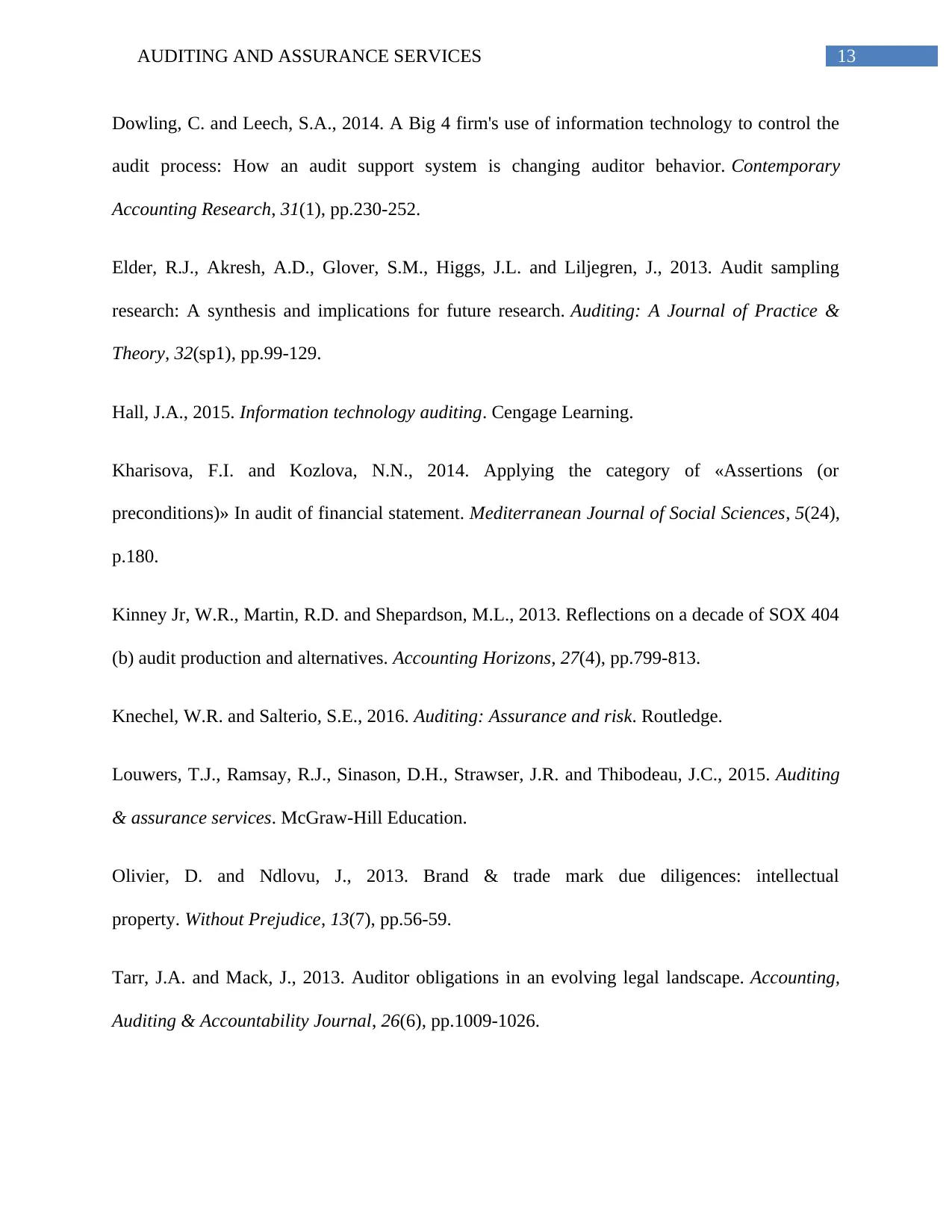
13AUDITING AND ASSURANCE SERVICES
Dowling, C. and Leech, S.A., 2014. A Big 4 firm's use of information technology to control the
audit process: How an audit support system is changing auditor behavior. Contemporary
Accounting Research, 31(1), pp.230-252.
Elder, R.J., Akresh, A.D., Glover, S.M., Higgs, J.L. and Liljegren, J., 2013. Audit sampling
research: A synthesis and implications for future research. Auditing: A Journal of Practice &
Theory, 32(sp1), pp.99-129.
Hall, J.A., 2015. Information technology auditing. Cengage Learning.
Kharisova, F.I. and Kozlova, N.N., 2014. Applying the category of «Assertions (or
preconditions)» In audit of financial statement. Mediterranean Journal of Social Sciences, 5(24),
p.180.
Kinney Jr, W.R., Martin, R.D. and Shepardson, M.L., 2013. Reflections on a decade of SOX 404
(b) audit production and alternatives. Accounting Horizons, 27(4), pp.799-813.
Knechel, W.R. and Salterio, S.E., 2016. Auditing: Assurance and risk. Routledge.
Louwers, T.J., Ramsay, R.J., Sinason, D.H., Strawser, J.R. and Thibodeau, J.C., 2015. Auditing
& assurance services. McGraw-Hill Education.
Olivier, D. and Ndlovu, J., 2013. Brand & trade mark due diligences: intellectual
property. Without Prejudice, 13(7), pp.56-59.
Tarr, J.A. and Mack, J., 2013. Auditor obligations in an evolving legal landscape. Accounting,
Auditing & Accountability Journal, 26(6), pp.1009-1026.
Dowling, C. and Leech, S.A., 2014. A Big 4 firm's use of information technology to control the
audit process: How an audit support system is changing auditor behavior. Contemporary
Accounting Research, 31(1), pp.230-252.
Elder, R.J., Akresh, A.D., Glover, S.M., Higgs, J.L. and Liljegren, J., 2013. Audit sampling
research: A synthesis and implications for future research. Auditing: A Journal of Practice &
Theory, 32(sp1), pp.99-129.
Hall, J.A., 2015. Information technology auditing. Cengage Learning.
Kharisova, F.I. and Kozlova, N.N., 2014. Applying the category of «Assertions (or
preconditions)» In audit of financial statement. Mediterranean Journal of Social Sciences, 5(24),
p.180.
Kinney Jr, W.R., Martin, R.D. and Shepardson, M.L., 2013. Reflections on a decade of SOX 404
(b) audit production and alternatives. Accounting Horizons, 27(4), pp.799-813.
Knechel, W.R. and Salterio, S.E., 2016. Auditing: Assurance and risk. Routledge.
Louwers, T.J., Ramsay, R.J., Sinason, D.H., Strawser, J.R. and Thibodeau, J.C., 2015. Auditing
& assurance services. McGraw-Hill Education.
Olivier, D. and Ndlovu, J., 2013. Brand & trade mark due diligences: intellectual
property. Without Prejudice, 13(7), pp.56-59.
Tarr, J.A. and Mack, J., 2013. Auditor obligations in an evolving legal landscape. Accounting,
Auditing & Accountability Journal, 26(6), pp.1009-1026.
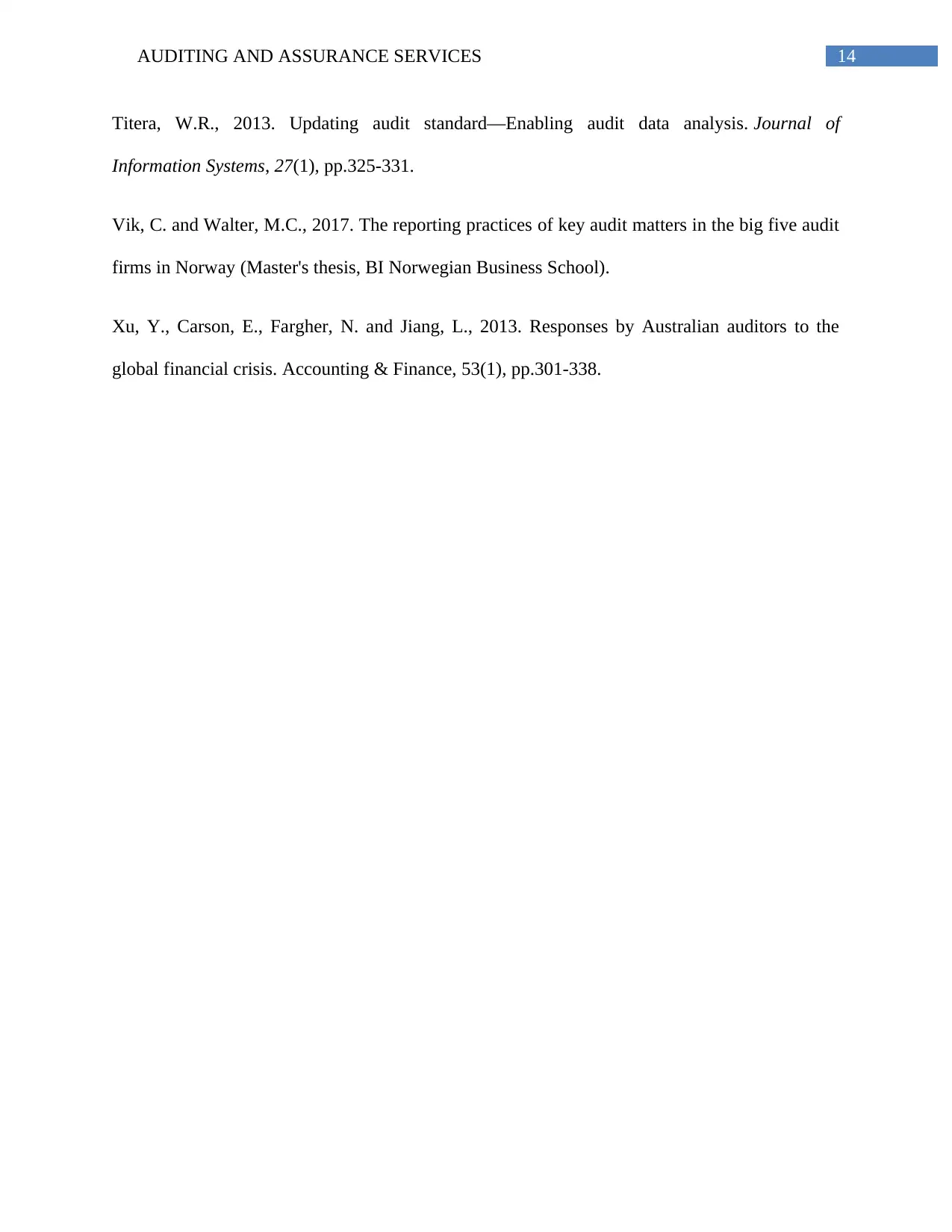
14AUDITING AND ASSURANCE SERVICES
Titera, W.R., 2013. Updating audit standard—Enabling audit data analysis. Journal of
Information Systems, 27(1), pp.325-331.
Vik, C. and Walter, M.C., 2017. The reporting practices of key audit matters in the big five audit
firms in Norway (Master's thesis, BI Norwegian Business School).
Xu, Y., Carson, E., Fargher, N. and Jiang, L., 2013. Responses by Australian auditors to the
global financial crisis. Accounting & Finance, 53(1), pp.301-338.
Titera, W.R., 2013. Updating audit standard—Enabling audit data analysis. Journal of
Information Systems, 27(1), pp.325-331.
Vik, C. and Walter, M.C., 2017. The reporting practices of key audit matters in the big five audit
firms in Norway (Master's thesis, BI Norwegian Business School).
Xu, Y., Carson, E., Fargher, N. and Jiang, L., 2013. Responses by Australian auditors to the
global financial crisis. Accounting & Finance, 53(1), pp.301-338.
1 out of 15
Related Documents
Your All-in-One AI-Powered Toolkit for Academic Success.
+13062052269
info@desklib.com
Available 24*7 on WhatsApp / Email
![[object Object]](/_next/static/media/star-bottom.7253800d.svg)
Unlock your academic potential
© 2024 | Zucol Services PVT LTD | All rights reserved.




